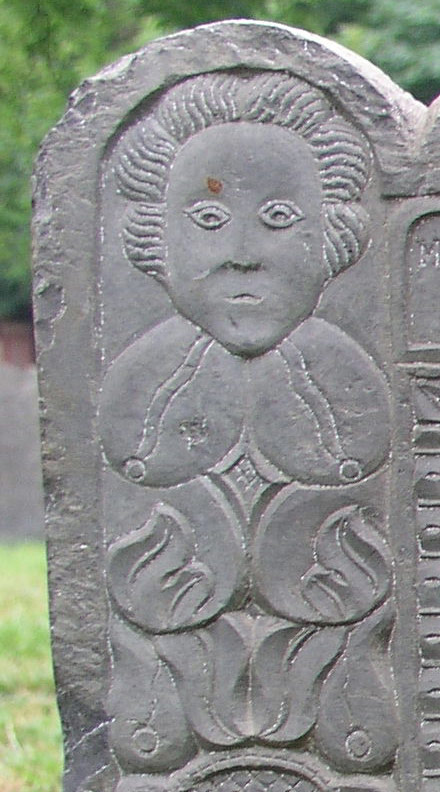Study Guide Death

Table of Contents
Weaned Affections
 One of the most important theological doctrines for Puritans was the doctrine of weaned affections. This concept argued that the individual must learn to wean his or herself away from earthly loves (such as husband, children, grandchildren, material possessions), and instead focus on God. Puritans feared that if one appreciated the sensual beauty and relations of this world, one might forget the ever-lasting beauty of the world of the spirit (Tolles 485). Implicit in the language of "weaning" is the notion that people are attempting to "nurse" or gain substance from the earthly realm, whereas proper sustenance comes from the mammary glands of God. Indeed the breasts of God are a popular Puritan trope in both sermons and tombstones (for example the tombstone of Sibyll Wigglesworth [1708], at the right). Another symbol associated with weaned affections is that of the skull which served “as a general reminder of the limits of time and our mortal existence, but it also functioned strategically to hold in check the human impulse toward…love of the world” (Stein 321). As a symbol of vanitas, the skull reminded viewers that worldly impulses such as wealth, beauty, and power, were part of a world of Evil that needed to be subdued (Stein 321). Poet Anne Bradstreet often depicts the tension between the world of the flesh and the world of the spirit in her poems: she balances her love this world with her knowledge that her affections belong elsewhere. The “dying Indians” in Indian Converts often chastise themselves for their previous folly in placing any faith in this world as they prepare to meet the next.
One of the most important theological doctrines for Puritans was the doctrine of weaned affections. This concept argued that the individual must learn to wean his or herself away from earthly loves (such as husband, children, grandchildren, material possessions), and instead focus on God. Puritans feared that if one appreciated the sensual beauty and relations of this world, one might forget the ever-lasting beauty of the world of the spirit (Tolles 485). Implicit in the language of "weaning" is the notion that people are attempting to "nurse" or gain substance from the earthly realm, whereas proper sustenance comes from the mammary glands of God. Indeed the breasts of God are a popular Puritan trope in both sermons and tombstones (for example the tombstone of Sibyll Wigglesworth [1708], at the right). Another symbol associated with weaned affections is that of the skull which served “as a general reminder of the limits of time and our mortal existence, but it also functioned strategically to hold in check the human impulse toward…love of the world” (Stein 321). As a symbol of vanitas, the skull reminded viewers that worldly impulses such as wealth, beauty, and power, were part of a world of Evil that needed to be subdued (Stein 321). Poet Anne Bradstreet often depicts the tension between the world of the flesh and the world of the spirit in her poems: she balances her love this world with her knowledge that her affections belong elsewhere. The “dying Indians” in Indian Converts often chastise themselves for their previous folly in placing any faith in this world as they prepare to meet the next.
Items Related to Weaned Affections in the Archive
Mourning Rings < Previous | Next > Elegies